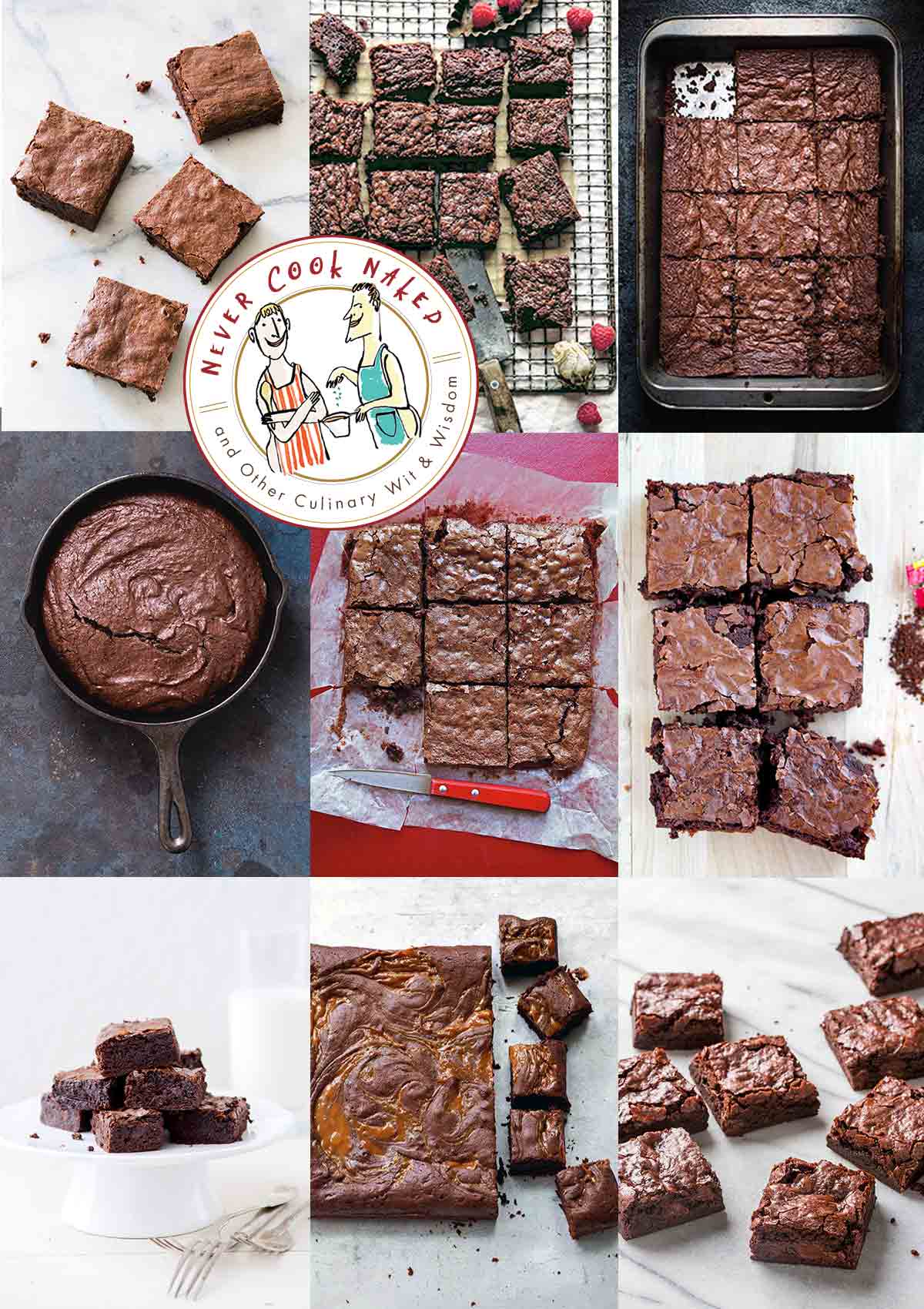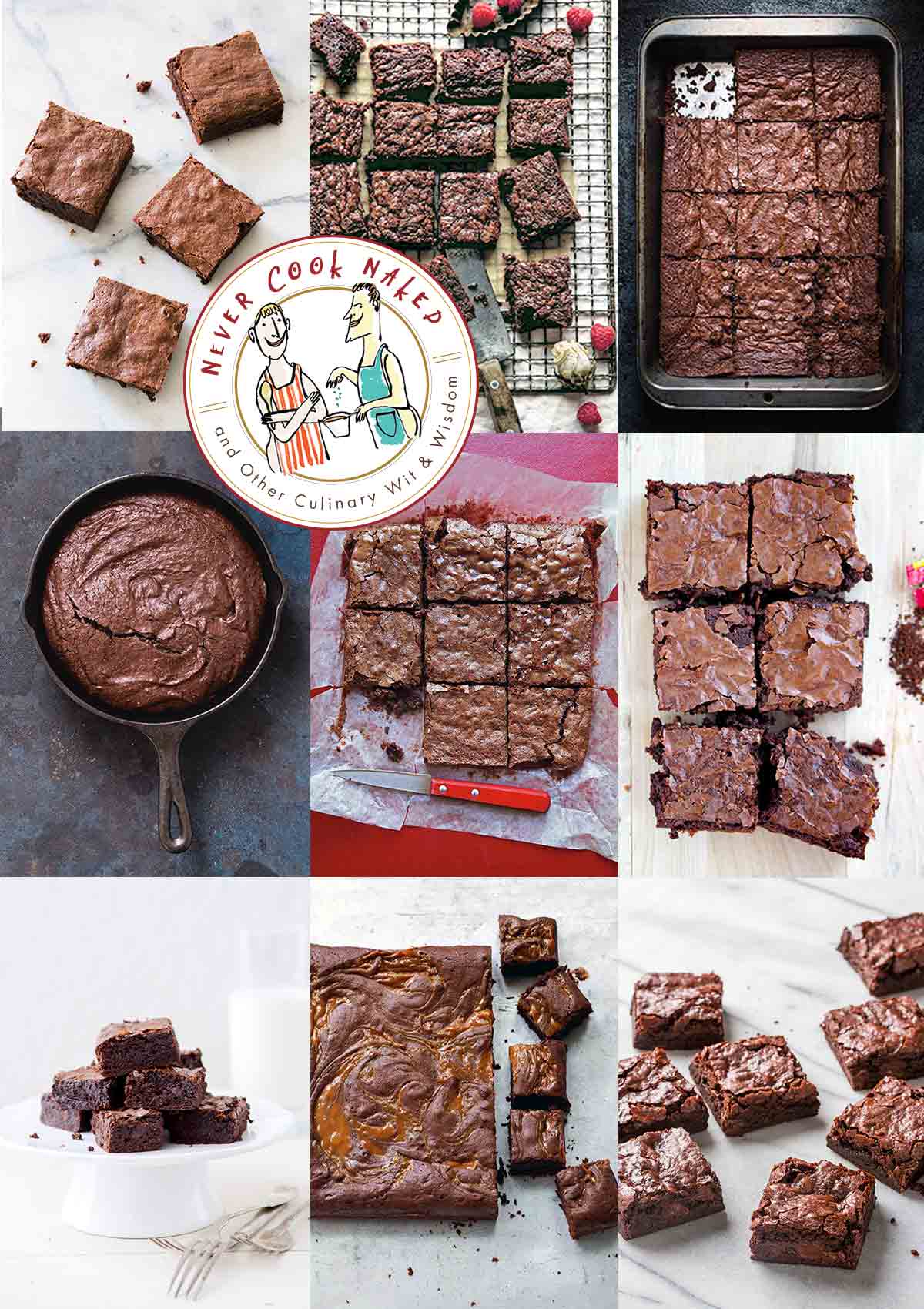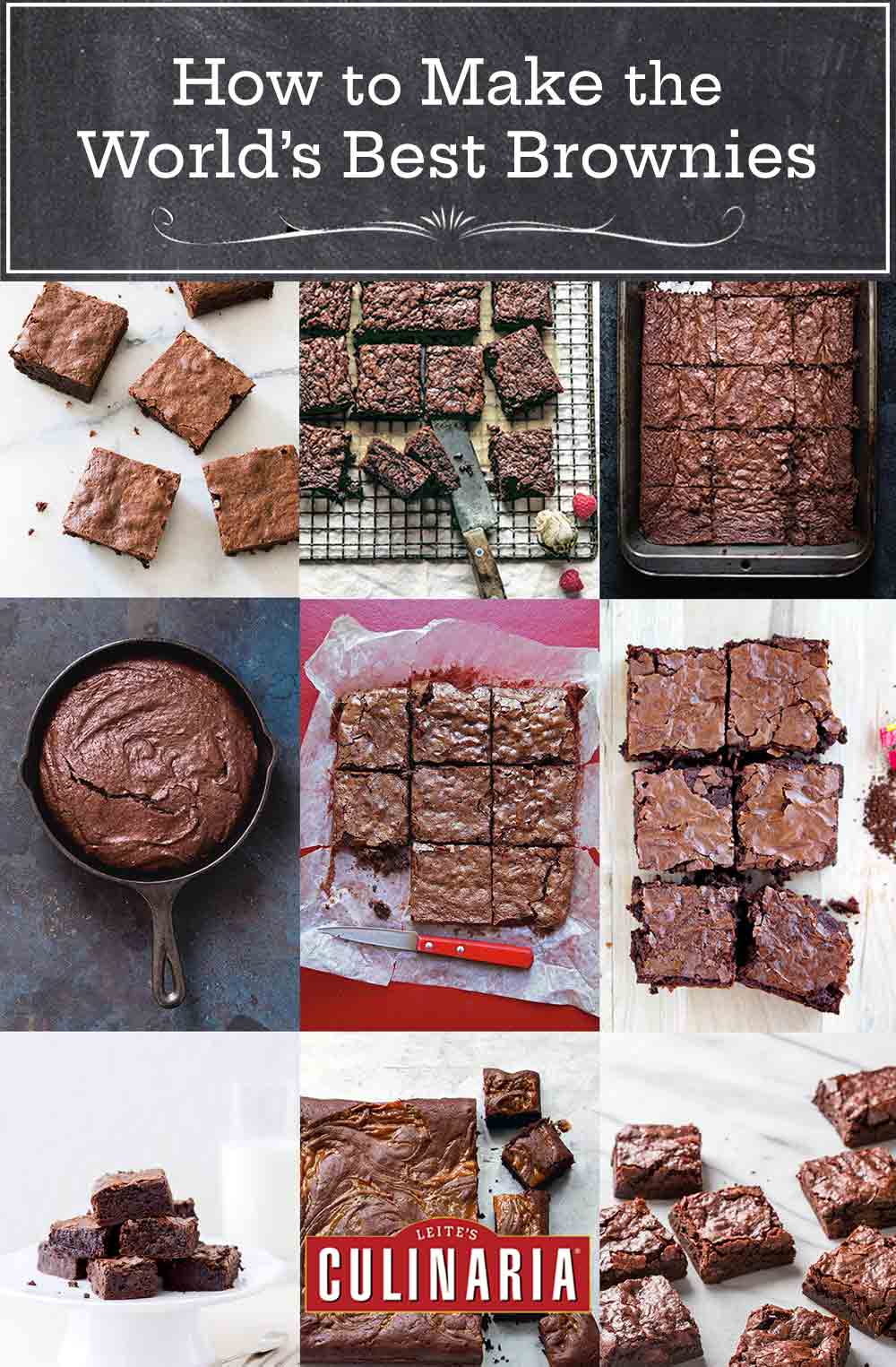

What’s the difference between fudgy and cakey brownies?
Dear Never Cook Naked Guys: I love brownies that are the perfect mix of fudgy and cakey, but I’m never sure how to tell if a recipe will give me my favored consistency. Is there a way to know what’s what before I bake a batch?—Afraid of Commitment
Dear Afraid: Wow—you not only want it all, you also want to know how it’s going to turn out in advance. Our guess is that you’re also one of the five truly independent voters left in the United States. Expect a lot of political phone calls this year while you’re making brownies.
Fortunately for you, brownie recipes follow a pretty simple ratio: the more butter and chocolate to flour, the fudgier the brownies; the less butter and chocolate to flour, the cakier. Figure that for 1 cup (135 grams) of flour, a fudgy brownie can have as much as 3 sticks [Editor’s Note: That’s a whopping 12 ounces or 340 grams, folks] of melted butter and 5 ounces (142 grams) of melted chocolate, and a cakey brownie can have as little as 2 tablespoons (1 ounce or 28 grams) of butter and 2 ounces (57 grams) of chocolate.
However, it’s not that simple. Never is. We haven’t yet mentioned what eggs do to the batter—or the inherent starchiness of unsweetened chocolate over semisweet.
You should probably be looking for a recipe that uses a combination of chocolates (unsweetened, semisweet, and cocoa powder, for example), a few more eggs than the standard, and a moderate balance of butter and chocolate to flour.
That said, we lowly columnists will never be able to find the right ratio for your favored consistency. You’re going to have to discover it the old-fashioned way: by trial and error. But that’s not the worst thing. You can learn to relish the joy of the unexpected, trays and trays of brownies at the ready in your kitchen. Would that choosing a political candidate lead to such delicious results!
How do I get that crackly crust on my brownies?
Dear Never Cook Naked Guys: What forms that luscious yet elusive crackly surface on brownies?—Always Hopeful But Often Disappointed
Dear Hopeful: Believe it or not, you’ve uncovered yet another divide in our modern democracy: Some people love that brownie crust; others despise it.
It’s actually caused by arguably poor technique: overbeating the batter after the eggs have been added.
Think of it this way: You almost can’t overbeat the sugar and butter at the start of a brownie recipe. The point is to build the batter’s structure by incorporating air into the fat as the sugar dissolves. But after the eggs and then the flour are added to that sugary, buttery goodness, when you beat the batter vigorously the proteins (those in the eggs as well as those in the flour) will stretch thin and dry out fast. This results, after baking, in a dry crackle over the fudgy chocolate below. In fact, that crust helps hold the very moist, dense brownie together.
Of course, one person’s poor technique is another’s pleasure. (See also Fifty Shades of Grey.) Some recipes—including David Lebovitz’s Best Brownies—actually traffic in that flaky, vaunted crust. In our opinion, it’s pure bliss. Heathens in the other camp should restrain themselves while beating once they’ve got the eggs in the mix.
How can I tell when my brownies are done?
Dear Never Cook Naked Guys: I would like to know a foolproof method for knowing when a brownie is done. —Still Just Standing Facing the Stove
Dear Standing: Our foolproof method is pretty easy: Read the recipe. You may also care to read the below question from Confused About the First Time regarding “Why Are My Brownies Barely Cooked? And our answer.
A trustworthy recipe will offer reliable physical, visual, even olfactory cues. Just don’t rely on timing, as unfortunately there’s no brownie recipe that actually allows you to heat an oven, mix a batter, and walk away. Any suggestion of minutes and hours should be viewed as a loose guide that simply tells you whether you’ll have warm brownies within the next half hour or so.
Brownies are not filet mignons. (Believe us, we’re still working to solve the culinary dilemma of crossing beef with chocolate. We’re also still trying to figure out how to cross Tyler Lautner with Matt Damon, but that’s another subject entirely.) So instant-read meat thermometers won’t work.
Most cakey brownies are proofed with a toothpick or metal cake tester, which should come out clean or with just a few moist crumbs attached, depending on the desired consistency. But pay attention to the other cues the author offers. Should the cake pull away from the sides of the pan? Should the top be dry and cracked?
Gooey, fudgy brownies are trickier. Toothpicks won’t do you much good, as they’ll come out gunked with prime-chocolate-ordial goo no matter how done or underdone your brownies are. Here, too, the other cues can be more exacting. Are the brownies supposed to be set on the sides but still jiggly in the middle? Are they supposed to emit a faint sizzling? Is the top supposed to be dry and firm despite being a bit raw underneath? Is it to be evenly puffed?
If your timeworn, batter-splattered recipe includes none of these cues, we have another foolproof method for perfect brownies: Find a better recipe.
Can I swap whole-wheat flour in my brownies?
Dear Never Cook Naked Guys: Can I substitute whole-wheat flour for all-purpose flour in a brownie recipe?—Always in Birkenstocks
Dear Birkenstocks: Playing with whole-wheat flour in a brownie recipe is something like going out for a bacon cheeseburger and ordering a diet soda. What’s the point? Brownies are indulgent: butter, sugar, chocolate, eggs. A smidgen of fiber is not going to save the day. Or your thighs.
But if you’re a fan of diet sodas—or worse yet, whole-grain hamburger buns (the horror!)—you can indeed put a little whole-wheat flour in a brownie recipe: not by a willy-nilly substitution but with a careful understanding that the germ and bran in whole-wheat flour are moisture sponges. They can render even brownies dry and downright unpleasant.
So follow these two rules in your futile quest for less guilt:
1. Do a partial substitution. And by that we mean no more than half the volume of all-purpose flour swapped out for whole wheat.
2. Use whole-wheat pastry flour, which is a much finer grind of softer wheat that won’t impede the gorgeous texture of brownies with too much chew.
And since you’re clearly into these sorts of bargains and rationalizations, go ahead and have a glass of whole milk with those whole-wheat-pastry-flour brownies.
Why does my brownie batter break?
Dear Never Cook Naked Guys: I just made David Lebovitz’s Best Brownies and I experienced the same thing that happened to a few others who’ve commented on the recipe. That is, my batter was fine until I added the all-purpose flour. Then when I stirred it, the batter totally broke. I was so disappointed. My eggs weren’t totally room temperature—I had them in warm water for a few minutes, so they weren’t completely cold, but they also probably weren’t as warm as they needed to be. What went wrong?—Brownie Deprived
Dear Deprived: When Emily Dickinson was in the last moments of her mortal coil, the family called in the doctor. She refused to see him, but she did agree to open her bedroom door and pass by it while he stood out in the hallway.
It’s tough to diagnose a problem from afar, but like the poet’s physician of yore, we’ll give it a shot.
We suspect the batter broke because the chocolate seized—that is, the cocoa solids fell out of suspension from the cocoa fat as it melted. Cocoa solids and cocoa fat exist in an uneasy alliance in chocolate, which is prone to seizing at high temperatures as well as during quick temperature fluctuations. As a general rule, dark chocolate will seize above about 120°F (49°C) and milk chocolate above about 110°F (43°C). All the “abouts” have to do with the varying ratios of solids and fats in different brands and lines of chocolate.
Your culprit may well have been the butter. Yes, it melts below the danger zone for chocolate at about 96°F (36°C). But it can quickly rise to temperatures well above its melting point. So if the butter got a tad too hot, that may have been what got you into trouble. What’s more, if the flour was around or below room temperature of say, 76°F (24°C), it may have dropped the temperature of the batter too quickly when it was added, which also could have caused the chocolate to seize.
The solution, just like the problem, has multiple components.
First, melt the butter slowly over very low heat. Don’t melt it in a microwave oven, which can create hot spots—even hidden ones that don’t roil and spew out of the bowl.
Second, if you think the temperature of the melted butter has risen too quickly or too far, cool it for five minutes or so before adding it to the other ingredients. A few moments of quiet repose may solve the problem.
Third, never make brownies with flour that’s straight from the fridge or freezer. Although some home cooks prefer to keep flour there to improve its shelf life, the attendant temperature shifts can be too much for some batters. And we’ve said nothing about the internal temperature of those eggs—which can make a slight difference, though we suspect it’s not at play here.
Finally, if the chocolate in your brownie batter does seize, trying beating in cream in one-tablespoon increments. The extra fat may help reincorporate the cocoa solids—although if the flour has gotten there first and coated the solids, protecting them from further bonding, you may be out of luck. Best to take it slowly from the get-go.
EDITOR’S NOTE: We heard back from Brownie Deprived, who made another batch of David Lebovitz’s Best Brownies after we shared this information, and, well, what can we say. We’re suckers for stories with fairy tale endings. Here’s what she has to say: “I just finished baking and cutting the brownies and wanted to let you know that they came out great! I was nervous because the batter still seemed a little grainy when I put them in the oven, but they came out perfect and waiting for them to cool was torturous. Now I know not to mess with temperatures with baking–this time I made sure everything was at room temperature and that seems to have done it. Thanks so much for all the help!”
Why are my brownies barely cooked?
Dear Never Cook Naked Guys: I’ve had my eye on the recipe for David Lebovitz’s Best Brownies for quite some time and was very excited to try it as part of my plan to become more comfortable with baking. I removed them from the oven at 30 minutes, and while they weren’t completely set, I heeded the advice not to overbake them. About 1 1/2 hours later, when they were mostly cool and I cut into them, I realized that they were mostly still batter and barely cooked. How can I correct this for next time? I followed the instructions to a T; the only difference was that I used medium eggs instead of large. Also, when beating the batter “energetically,” I beat it for well over 60 seconds to try to achieve the smooth texture. I also stirred in toasted hazelnuts, if that makes any difference. Please help! —Confused About the First Time
Dear Confused: We went the distance for you, buddy. We made this recipe this morning. It was quite a sacrifice, but we’ll try to answer despite having our mouths full and crumbs in our keyboard.
You seem rather hung up on the matter of timing. You need to think of timing for baking recipes more like traffic lights in Manhattan: mere suggestions. All ovens are different, with hot and cold spots. What’s more, no oven temperature is ever stable. It has to drop several degrees below the stated temperature before the heating element kicks in and blasts the temperature several degrees above the stated temperature. This happens over and over again. Plus, ovens are cranky. Like pianos, they go out of whack over time and need adjusting.
Whenever we bake—or roast, for that matter—we look at the number of minutes suggested and set the timer for about 20 percent fewer. Recipe states 20 minutes? We set the timer for 16. Calls for 30? Then check at 24. Two hours? An hour and a half. That way, we can see where we are before problems develop. To wit, these brownies were done this morning at 23 minutes, not 30. The top was dry; the center underneath felt almost set, if a little oozy, though certainly not liquid-y. It’s all about the given day’s humidity, the temperature of the ingredients, the temperature of the baking pan, and even more esoteric ineffables.
The medium eggs actually landed you with a drier batter. In fact, the smaller eggs could explain if your batter was grainy. The sugar didn’t have enough liquid to dissolve.
So we suspect you got hung up on the letter of the law, not its spirit. Trust the visual, aural, and olfactory cues for a baking recipe. Timing is a ditzy guide, the Julie McCoy of your culinary Love Boat.
How do I clean my brownie pan?
Dear Never Cook Naked Guys: I’ll admit it. I make really good brownies. My husband starts to vulture the pan while the brownies are still warm. Twenty-four hours later, I inevitably find the pan empty except for several neatly squared-off remainders. Often the brownie-coated knife is still in the pan, too. How do I encourage the person I love and cherish to go the distance and clean up the pan? After seven years of marriage, is that a scary level of commitment to ask for?—A Less-Than-Merry Wife of Windsor
Dear Less-Than-Merry Wife: We understand your pain. When we were first together, one of us (the thinning blond) cooked while the other (the graying brunette) stood guard with a sponge and a spray bottle. Then we went to therapy. We’ll save you five thousand bucks and 10 years of taking the train to the Upper West Side weekly just by telling you what we learned: In a relationship, you can only clean up your side of the street.
So if you’re tired of this, we suggest you make those lovely brownies, slice them into squares, pry them out of the pan, stack them on a platter, and stick the pan in the dishwasher yourself. Then pat yourself on the back. You took care of your issues yourself.
See, everyone’s a big package. You unwrap someone and find things you like as well as things you don’t. It’s important that the former always outweighs the latter. When they don’t, you’ll need to take the train to the Upper East Side to see a good lawyer. But surely a brownie pan isn’t a tipping point.
Besides, brownies shouldn’t be a referendum on a relationship. Sometimes, food is just food. You’ll only hear us say that this once. But times like these call for drastic measures.
Our very clever, very clothed Never Cook Naked columnists are at your disposal, able to troubleshoot everything from questionable table etiquette to tricky cooking techniques (as well as, natch, proper cooking attire). Curious to learn more solutions to culinary conundrums? Just ask! Drop us a comment below.
Originally published October 3, 2012.










Poosie, way ahead of you. Most of our recipes have a US/METRIC button at the top of the ingredients list. All you have to do is click it and everything will convert.
Who knew. Sometimes we pastry chefs are know it alls. And while we do know things I would never have guessed that the crackly top to my brownies which I could never eliminate by changing the recipe alone, is the result of technique. I roasted a chicken—-using Ina Garten’s recipe with tarragon instead of thyme and added a wilted spinach salad and herbed bisquits. When it came to desert I wanted brownies with vanilla ice cream. That’s when the heavens opened and dropped the brownie primer in my lap. And lo…the reason for my crackly tops was revealed. Following the advice in the primer, I made David Lebovitz’ recipe taking care to fold in the flour just before putting the batter in the oven. Low and behold no crackle. Dense. Fudgie. Perfect with vanilla ice cream. Fold in the flour, do it gently and there will be no crackle.Thank you Leite’s Culinaria! Thank you Naked Chefs.
You’re so welcome, Diane! Your dinner plans sound so comforting and delicious, what time should we swing by?